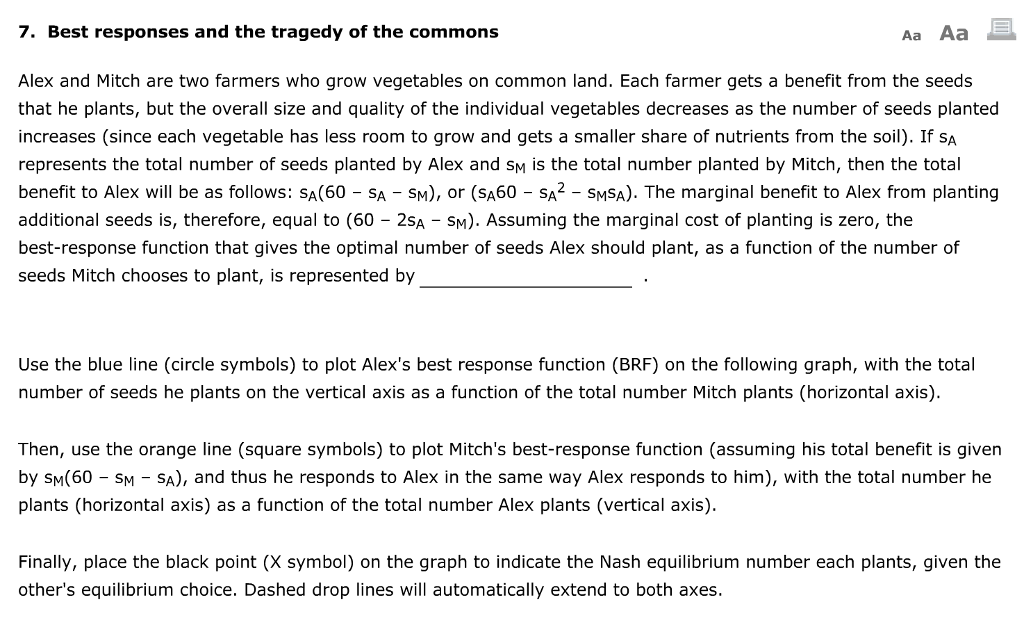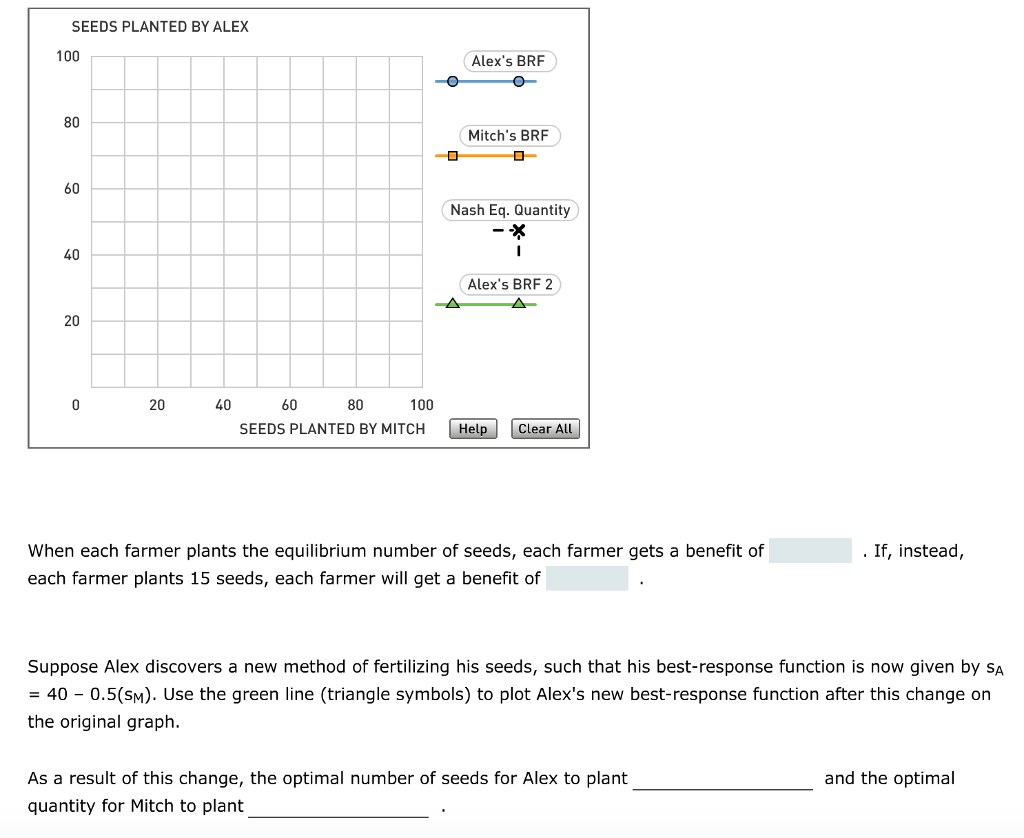SEEDS PLANTED BY ALEX 100 80 60 40 20 0 20 40 60 80 SEEDS PLANTED BY MITCH 100 O Alex's BRF O- Mitch's BRF Nash Eq. Quantity --X I Alex's BRF 2 Help Clear All When each farmer plants the equilibrium number of seeds, each farmer gets a benefit of each farmer plants 15 seeds, each farmer will get a benefit of If, instead, Suppose Alex discovers a new method of fertilizing his seeds, such that his best-response function is now given by SA = 40 - 0.5(SM). Use the green line (triangle symbols) to plot Alex's new best-response function after this change on the original graph. As a result of this change, the optimal number of seeds for Alex to plant quantity for Mitch to plant and the optimal
SEEDS PLANTED BY ALEX 100 80 60 40 20 0 20 40 60 80 SEEDS PLANTED BY MITCH 100 O Alex's BRF O- Mitch's BRF Nash Eq. Quantity --X I Alex's BRF 2 Help Clear All When each farmer plants the equilibrium number of seeds, each farmer gets a benefit of each farmer plants 15 seeds, each farmer will get a benefit of If, instead, Suppose Alex discovers a new method of fertilizing his seeds, such that his best-response function is now given by SA = 40 - 0.5(SM). Use the green line (triangle symbols) to plot Alex's new best-response function after this change on the original graph. As a result of this change, the optimal number of seeds for Alex to plant quantity for Mitch to plant and the optimal
Principles of Economics 2e
2nd Edition
ISBN:9781947172364
Author:Steven A. Greenlaw; David Shapiro
Publisher:Steven A. Greenlaw; David Shapiro
Chapter12: Environmental Protection And Negative Externalities
Section: Chapter Questions
Problem 10SCQ: Suppose a city releases 16 million gallons of raw sewage into a nearby lake. Table 12.8 shows the...
Related questions
Question
Sub : Economics
Pls answer very fast.I ll upvote correct answer. Thank You

Transcribed Image Text:7. Best responses and the tragedy of the commons
Aa Aa
Alex and Mitch are two farmers who grow vegetables on common land. Each farmer gets a benefit from the seeds
that he plants, but the overall size and quality of the individual vegetables decreases as the number of seeds planted
increases (since each vegetable has less room to grow and gets a smaller share of nutrients from the soil). If SA
represents the total number of seeds planted by Alex and SM is the total number planted by Mitch, then the total
benefit to Alex will be as follows: SA(60 - SA - SM), or (SA60 - SA² SMSA). The marginal benefit to Alex from planting
additional seeds is, therefore, equal to (60 - 2SA - SM). Assuming the marginal cost of planting is zero, the
best-response function that gives the optimal number of seeds Alex should plant, as a function of the number of
seeds Mitch chooses to plant, is represented by
Use the blue line (circle symbols) to plot Alex's best response function (BRF) on the following graph, with the total
number of seeds he plants on the vertical axis as a function of the total number Mitch plants (horizontal axis).
Then, use the orange line (square symbols) to plot Mitch's best-response function (assuming his total benefit is given
by SM(60 - SM - SA), and thus he responds to Alex in the same way Alex responds to him), with the total number he
plants (horizontal axis) as a function of the total number Alex plants (vertical axis).
Finally, place the black point (X symbol) on the graph to indicate the Nash equilibrium number each plants, given the
other's equilibrium choice. Dashed drop lines will automatically extend to both axes.

Transcribed Image Text:SEEDS PLANTED BY ALEX
100
80
60
40
20
0
20
40
100
80
SEEDS PLANTED BY MITCH
60
Alex's BRF
o-
Mitch's BRF
Nash Eq. Quantity
Alex's BRF 2
Help Clear All
When each farmer plants the equilibrium number of seeds, each farmer gets a benefit of
each farmer plants 15 seeds, each farmer will get a benefit of
. If, instead,
Suppose Alex discovers a new method of fertilizing his seeds, such that his best-response function is now given by SA
= 40 - 0.5(SM). Use the green line (triangle symbols) to plot Alex's new best-response function after this change on
the original graph.
As a result of this change, the optimal number of seeds for Alex to plant
quantity for Mitch to plant
and the optimal
Expert Solution
This question has been solved!
Explore an expertly crafted, step-by-step solution for a thorough understanding of key concepts.
This is a popular solution!
Trending now
This is a popular solution!
Step by step
Solved in 5 steps with 6 images

Knowledge Booster
Learn more about
Need a deep-dive on the concept behind this application? Look no further. Learn more about this topic, economics and related others by exploring similar questions and additional content below.Recommended textbooks for you

Principles of Economics 2e
Economics
ISBN:
9781947172364
Author:
Steven A. Greenlaw; David Shapiro
Publisher:
OpenStax

Essentials of Economics (MindTap Course List)
Economics
ISBN:
9781337091992
Author:
N. Gregory Mankiw
Publisher:
Cengage Learning

Principles of Economics 2e
Economics
ISBN:
9781947172364
Author:
Steven A. Greenlaw; David Shapiro
Publisher:
OpenStax

Essentials of Economics (MindTap Course List)
Economics
ISBN:
9781337091992
Author:
N. Gregory Mankiw
Publisher:
Cengage Learning